TPO Roofing • What It Is, Pros, Cons, FAQs, and More
By Jack Gray, Roof Online Editor • Last updated August 7, 2024
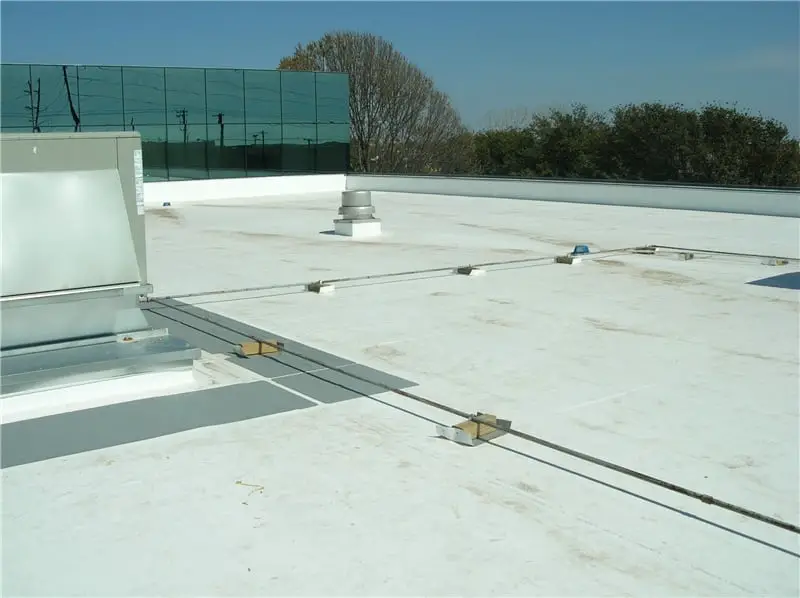
Table of Contents
Introduction
TPO roofing is becoming more and more familiar to building owners and property managers – it’s that bright white roofing membrane constantly being recommended by roofing contractors.
The first time a “TPO-type” roofing product was used in the U.S. was around 1987 and TPO roofing successfully entered the US commercial roofing market in the 1990s. In the last 15 years, interest in TPO single-ply roofing has skyrocketed.
We’ve noticed more and more clients asking about TPO when their old roofs are starting to fail and it’s time to discuss a roof replacement.
TPO is now the most popular single-ply roofing membrane in the United States when it comes to new low-slope roofing applications.
Unfortunately, it’s hard for most people to find good information on TPO roofing. There is no reputable TPO Roofing Association the way there’s an EPDM Roofing Association.
Because TPO roofing systems have a relatively limited history of use in the United States, there isn’t a large body of TPO roofing research, technical papers, practical guides, or other reliable reference resources in English like there is for more established materials such as asphalt, EPDM, or PVC.
Most of the TPO roofing information that you find on the internet was written by a roofing contractor who is trying to sell you a TPO roof.
We’re professional roof consultants – professional roof experts, you might say. Our clients include homeowners associations, corporate real estate asset managers, property managers, and facility directors.
As a part of our job, we research and write specifications for new TPO roofs. We inspect existing TPO roofing systems on commercial facilities and provide quality assurance during TPO roofing system installations. We’ve overseen maintenance and leak repair programs for quite a few TPO roofs.
We have to make sure we’re up-to-date on the latest developments in TPO roofing.
We know TPO roofing pretty well, and we thought we would share some helpful information about TPO roofing systems here on our website.
Pros & Cons of TPO Roofing
In case you’re just reading this article to get a quick sense of the advantages and disadvantages of a TPO roof, here’s a short run-through of the strong points and weak points of TPO roofing. We’ll be covering all of these items in more depth in the rest of article.
Pros of TPO Roofing
Cool Roof
Standard thermoplastic polyolefin roof membranes come with a white, highly reflective surface for energy savings, LEED points, etc. Installing TPO single ply membrane roofing is widely considered to be a cost effective way to improve your building’s energy efficiency.
Water Resistance
TPO roofing is more resistant to ponding water (standing water on the roof) than most other types of modern roofing membrane. It’s often used as a pond liner.
Decent Grease Resistance
When compared to EPDM or asphalt-based roofs (such as built-up or modified bitumen), TPO roofing is far, far more resistant to the kitchen grease that can build up on a roof thanks to kitchen exhaust fans.
Just remember that even though TPO is a solid choice for a restaurant roof, PVC roofing is better, and a proper rooftop grease containment system is always strongly recommended for restaurant roofs.
Lower Material Cost
TPO is usually somewhat cheaper than other white single-ply systems of the same thickness and attachment style. Mechanically-fastened 45-mil TPO is the cheapest reflective white commercial roof system there is.
The cost of TPO roofing is commonly considered one of the main benefits of the TPO single-ply membrane roofing system.
Lower Installation Cost
It’s easy to get competitive bids for a TPO roofing installation. Every commercial roofer on the planet seems to specialize in TPO these days. This makes it easy to put together a bid list full of qualified roofers to get the best price you can.
(Recycling)
You may see claims that TPO is made of recycled materials. This is sort of, technically, legalistically true. They often contain about 10% pre-consumer recycled content.
While TPO membranes are themselves recyclable, this doesn’t mean that old TPO roofing material gets turned into new roof membranes.
New high quality TPO membranes will usually contain around 10% pre-consumer recycled material, and 0% post-consumer recycled content. This means than no old TPO roofing gets removed from a roof, recycled, and used to make new TPO membranes.
Cons of TPO Roofing
Easily Punctured
When compared to the two other main types of single-ply membrane, TPO falls in the middle when it comes to puncture resistance. It is tougher than EPDM, but not as tough as PVC.
But the important thing to remember is that TPO is still a single-ply material, which means that it is far more susceptible to punctures (and puncture-related leaks) than other low-slope roofing materials such as built-up roofing or modified bitumen membranes.
Limited Track Record
TPO has a much shorter track record than other roof systems. Best practices for TPO roofing are still being developed. Optimal formulations for TPO are still being worked out by roofing manufacturers.
Membrane Material Consistency
Material consistency during the production of TPO sheets is relatively hard to maintain. Among other issues, this can cause problems with heat-welding the membrane seams when different parts of the same sheet have different temperature windows.
This was more of a problem in the early years of TPO than it is now. But you should still only use TPO materials from manufacturers with excellent reputations and production standards.
Shorter Lifespan
In our experience and the experience of other roof consultants we’ve talked to, thermoplastic polyolefin roofs have a shorter lifespan than other single-ply roof systems with the same membrane thickness and membrane attachment style.
Roof Cleaning
White TPO, like all white roof membranes, will need to be cleaned every two or three years to maintain the energy savings that a cool roof membrane provides. When it gets dirty, its reflectance score drops.
Stiff Membrane
TPO membranes are stiffer and don’t conform to angle changes as well as other single-ply membranes. This makes it harder to work with, which can result in more installation errors even when it’s installed by trained roofers if they lack experience with TPO.
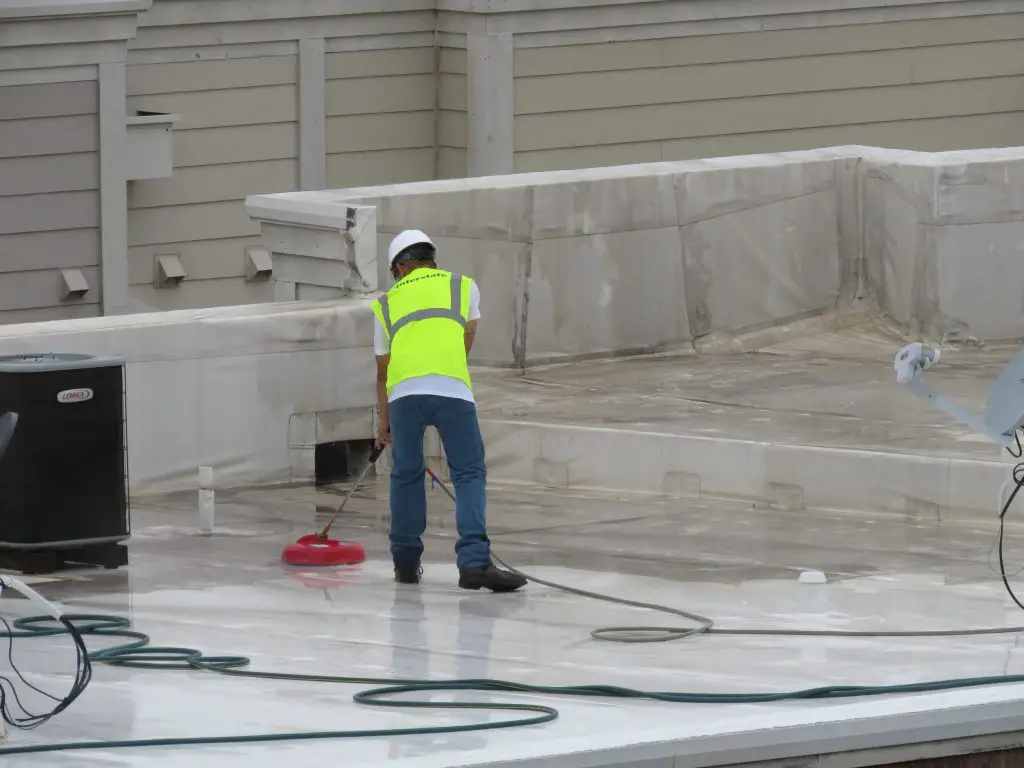
What is TPO Roofing?
TPO roofing is a type of single-ply roofing in which sheets of TPO membrane are used as the primary waterproofing material. TPO, which stands for “thermoplastic polyolefin”, is heat-weldable (that’s the thermoplastic part) and extremely UV-resistant.
“Single-ply roofing is a roofing system in which the principal roof covering is a single layer flexible membrane, often of thermoset, thermoplastic, or polymer modified bituminous compounds.” (from RCI’s Glossary of Roofing Terms)
TPO Roof Membrane
The TPO membrane is delivered from the factory in large rolls. The sheets are typically 10 feet wide and 100 feet long, although there are many other sizes available.
The standard thicknesses of TPO roof membranes are 45-mil, 60-mil, and 80-mil. (A “mil” is 1/1000 of an inch, it does not stand for “millimeter”). The thicker the material is, the longer the roofing membrane normally lasts, and the longer the warranty coverage will normally be.
A sheet of TPO roof membrane has three layers: a TPO polymer base, a polyester reinforcement fabric middle layer (called the “scrim”) and a TPO polymer top ply. These three layers are heat-fused at the factory to produce the final product.
The main chemical component in a TPO roof membrane is propylene ethylene copolymer. The finished TPO products also contain fire retardant chemicals, colorant, ultraviolet radiation absorbers such as titanium dioxide, and possibly other proprietary additives.
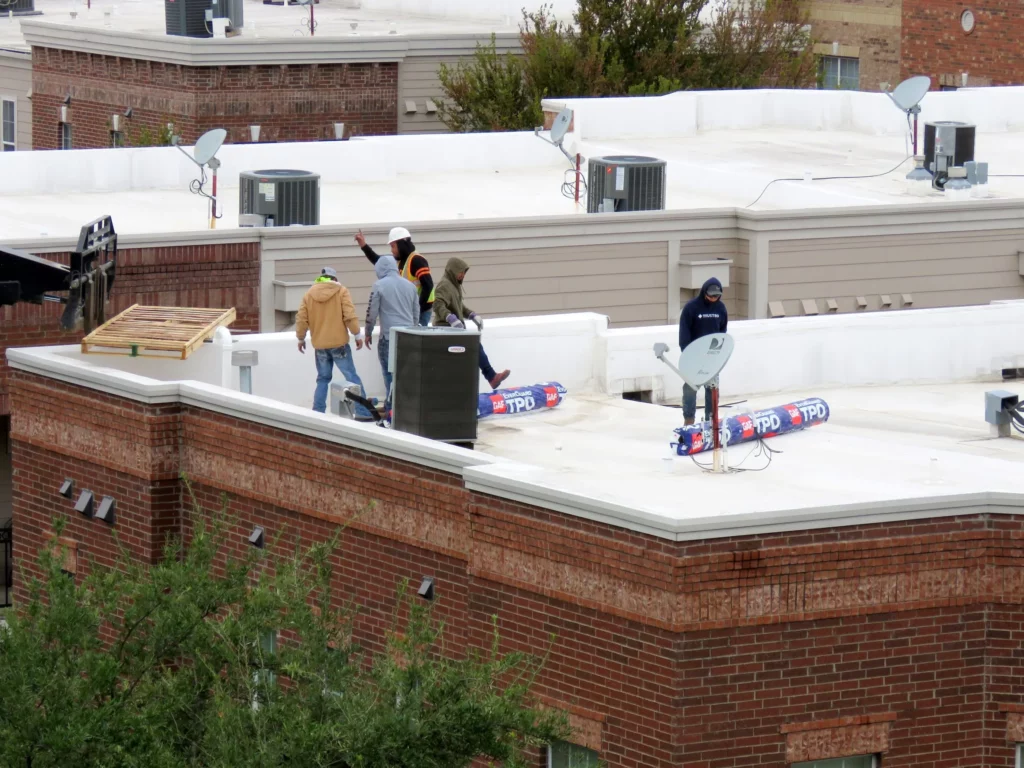
Heat-Welding TPO
Thermoplastic polyolefin roofs are installed the same way that PVC roofs are, using extremely hot air to join the TPO sheets together to create a continuous waterproof barrier that covers the entire surface of the roof.
TPO membranes are thermoplastic, unlike EPDM roofing, for instance, which is thermoset. Thermoplastic means that you can always use heat (hot air at roughly 1000° Fahrenheit) to weld patches onto or otherwise modify a TPO membrane for the life of the roof.
(Thermoset means you can’t. You have to use adhesives.)
This heat is applied using either a hand-held hot air welding gun or a self-propelled automatic hot air welding machine (called a “robot” by TPO roof installers). The robot is used for the long seams in the field of the roof, while the heat gun is used for flashings and patches.
Heat welding is the proper way to seam TPO sheets together, to install TPO roof flashings, and to apply patches to the roof if it needs to be repaired.
The heat-welded seams in a TPO roof system are exceptionally strong, actually stronger than the rest of the TPO sheet.
Having heat-welded seams means that adhesives are not used to join the roof membrane sheets together, so adhesive failure and seam delamination are not problems for TPO roofs.
Unlike PVC, which is TPO’s main competitor as a white, cool roof membrane, the TPO roof membrane material does not rely on plasticizers to maintain flexibility over the life of the roof.
This means that the membrane does not lose flexibility over time because of plasticizer loss.
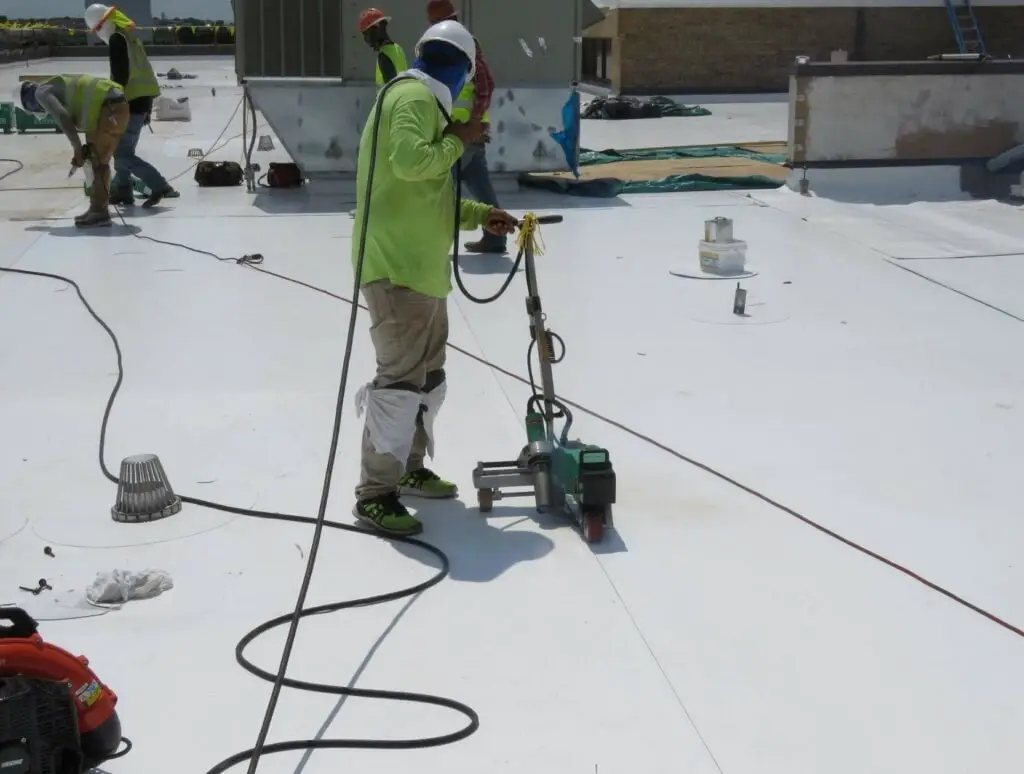
Typical TPO Roof Assembly
A typical TPO roof assembly consists of 1) the roof deck, usually concrete or corrugated steel, 2) a layer of insulation (commonly polyisocyanurate or expanded polystyrene insulation) that varies in thickness according to local R-value requirements; these days 3 – 5 inches is common 3) a cover board (most commonly 1/2-inch or 5/8-inch gypsum board with a fiberglass facer), and 4) the TPO membrane itself.
A vapor barrier installed over the roof deck may be required in many areas, depending on the local climate.
The typical installed thickness of a new TPO roof system (excluding the roof deck) will be around 5 inches, but this will vary according to the insulation type and local R-value requirements.
A typical TPO roof system weighs a little over 3 pounds per square foot (excluding the roof deck).
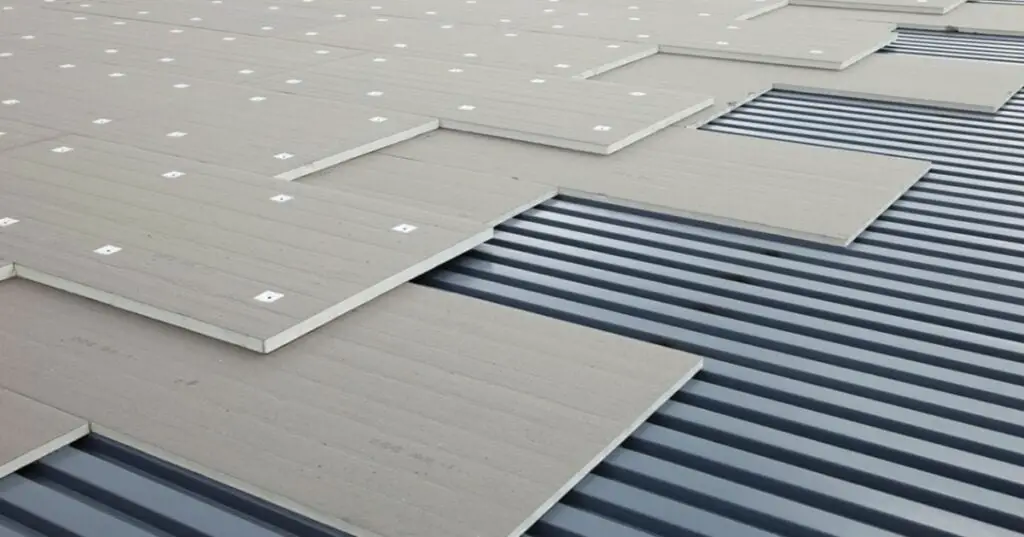
Almost all TPO membranes are either fully-adhered, which means that the entire membrane is glued to the cover board, or mechanically-attached, which most often means that the TPO roofing sheets are individually fastened down into the roof deck using a line of fasteners which are hidden inside the heat-welded seams which join the sheets together.
TPO roofing can also be ballasted, an attachment system in which the layers of the roof system are loose-laid, without fasteners or adhesives, and depend on ballast weight to hold the roof in place.
The ballast normally consists of river-washed stones or concrete pavers installed across the entire surface of the roof at an installed weight of 10 – 20 pounds per square foot.
Ballasted TPO roof systems are rare because the ballast covers up the roof membrane, cancelling the reflective value of a white TPO roof.
This short video from Carlisle SynTec Systems will give you a good idea of how a mechanically-attached TPO roof system is put together, although it’s very basic and doesn’t include the cover board that usually goes over the insulation:
TPO Roof Membrane Colors
All TPO roofing membranes have a gray bottom ply, which nobody can see once it’s installed. A huge majority of thermoplastic polyolefin roofs are white, that is, they have a white top ply.
This is understandable, since a huge reason for using TPO is that it can provide a reflective cool roof membrane, and white membranes are the most reflective.
TPO roofing actually comes standard from most manufacturers in more than just white. You can get TPO in white, tan, and gray from almost all manufacturers without it being a special order.
Many other custom colors are available as well, but you normally have to order enough of the material to make it worth the manufacturer’s while.
GAF TPO roofing, for instance, can be manufactured in 15 pre-formulated TPO colors, including green and red, but you need to order at least 40,000 square feet worth of membrane in order for them to make it for you.
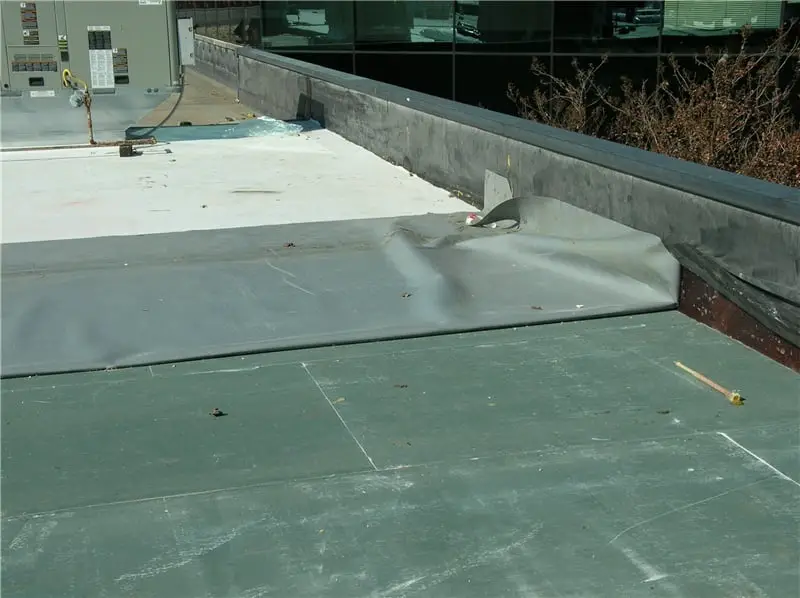
TPO Roofing Solar Reflectance
One assumption that a lot of people have about colored TPO is that if the roof membrane isn’t white, it won’t be as “cool” and it won’t qualify for LEED points.
This is only partially true. The solar reflectance of tan TPO roofing, for instance, isn’t much lower than that of the white TPO. Colored TPO membranes can meet energy savings requirements and qualify for LEED points.
To earn LEED credits, a low-sloped roof surface needs a minimum initial SRI of 82 or a minimum three-year aged SRI of 64. You can read more about LEED roof credits on the Buildings website.
The initial solar reflectance (Solar Reflectance Index – ASTM E1980) for white TPO is 99. The initial solar reflectance is 86 for tan TPO. (And it’s 53 for gray TPO.)
And the 3-year aged Solar Reflectance Index for white TPO is 85, while for tan TPO it’s 77. (And 48 for gray TPO.)
These are numbers you can work with.
Note: These values can vary by manufacturer and specific product. Product data sheets should always be available on the roofing manufacturer’s website where you can find the solar reflectance information for any roof membrane (normally under “Radiative Properties”).
Appropriate Uses for TPO Roofing
TPO can be installed on just about any building with a low-slope (“flat”) roof. Buildings with flat roofs are designed for low-slope roofing systems like TPO. A low-slope roof is a roof with a slope that is less than 3-in-12 (< 14.04°).
TPO roofing is not appropriate for steep roofs. Buildings with steep roofs are typically designed for steep roofing systems like shingles or tiles. A steep roof is considered to be any roof with a slope that is 3-in-12 or more (≥ 14.04°).
The minimum allowable roof slope for a TPO roof is ¼-in-12 (1.19°), as prescribed by the International Building Code. No maximum slope is specified.
If a cool roof is appropriate for your building, then TPO roofing is an appropriate choice. Whether a cool roof is always appropriate for every building in every climate is another matter altogether, and there’s an ongoing debate around the subject. But that would be the subject of an entirely different article.
Commercial TPO Roofing
TPO is a huge part of the commercial roofing industry. Thermoplastic polyolefin roofs are installed on office buildings, apartment buildings, hotels, factories, warehouses, shopping malls, big box stores, hospitals, schools, and other government buildings.
Almost every commercial roofing company in the country will have experience with TPO roofing and offer TPO roofing installation as one of their services.
Get Competitive Bids
There’s a lot of money in commercial TPO roofing, and too much of it might be coming out of your pocket.
To avoid paying way too much for your TPO roof, you need to get competitive bids, based on an accurate TPO roof specification, from 4 or 5 different roofing contractors.
If you don’t want to hire a roof consultant to produce a spec, the best TPO roofing manufacturers can often provide you with a decent roof specification for free. The spec will be generic (not customized for your roof) but it will be better than nothing.
There will be contact information for the TPO roofing manufacturer’s technical department on the manufacturer’s website. Call them and ask about it. They will probably be able to recommend a few of the best TPO roof installers in your area, as well.
If you let a roofing salesman talk you into awarding his company a roof installation contract without a competitive bidding process, you will end up overpaying for your new roof, possibly by as much as 30%.
As roof consultants, we know a lot of roofing company salesmen and estimators, and we know the cost of labor and material. So we know what a new roof should cost.
But we were surprised during a recent conversation with a salesman for a top 5 national roofing contractor. The salesman claimed that his company’s top competitor routinely turned a profit of around 40% on most of the roofs they installed. We found that hard to believe, but he convinced us it was true.
He said that his own company only averaged around 25%, and less than that when they successfully bid on one of our jobs.
We never include this other company on our bid list, so we had no idea they were charging so much and getting away with it. They rarely bid on jobs when there’s a roof consultant involved, because they can make a lot more money from less savvy customers.
Their sales team is simply that good. (Unfortunately, their roofers aren’t, we’ve inspected their work.)
Use a Roof Consultant
We strongly recommend that you hire a professional roof consultant if you’re planning to have a large commercial TPO roof installed.
A roof consultant can make sure you don’t get taken advantage of in an industry not known for its ethics.
While a roof consultant will typically charge about 5% – 10% of the total cost of the project, they can often reduce what you would otherwise end up paying for the roof by writing a precise roof specification, conducting a competitive bid process, and enforcing the contract documents.
The independent quality assurance inspections a roof consultant can provide often save a ton of headaches down the road.
The value of a roof consultant for long-term roof performance and roof life expectancy is well-documented. It’s why many insurance companies often require the involvement of an accredited roof consultant in order for the building owner to get the best rates on their insurance.
Residential TPO Roofing
TPO roofing is not normally considered residential roofing, although it’s a perfectly fine choice for apartment buildings, condominiums, and other residential buildings with flat roofs. It’s not good for most houses.
A lot of people want to know if they can install TPO roofing on their house. The short answer is no, not if your house was designed for a steep roof material. And you probably wouldn’t want to put it on your house anyway because of the way it would look.
First of all, one thing you have to take into account is how dirty a white TPO roof membrane will get after just a year or two.
Everyone can actually see a pitched roof, it’s not hidden out of sight like a flat roof. A new gleaming white TPO roof would take less than a year or two to become an unattractive gray, dirt-streaked roof. You’d have to wash it every year to keep it presentable.
Second of all, TPO is a flat (low-slope) roofing material. Flat roofs and steep roofs and the buildings underneath each one are designed differently.
A TPO membrane doesn’t just form a watertight membrane, it also forms an airtight (and water-vapor-tight) membrane as well. If you put a TPO roof on your pitched roof you’ll end up trapping debilitating amounts of heat and moisture underneath the roof.
Both the heat and the moisture can cause big problems. Dry rot, mold, and warped sheathing can result. Because a shingled roof does not form a continuous barrier, it allows the heat and moisture to pass harmlessly up and out through the roof.
The various building systems in buildings with low-slope roofs are engineered to account for this issue.
That being said, if your house has a flat roof on it, then yes, you can install TPO roofing on your house.
TPO roofing can also be used for some other roofs on residential properties. Even pitched roofs on unheated buildings such as sheds or barns are suitable. Flat roof sections over porches, garages, and even some dormers will have been designed for a low-slope material.
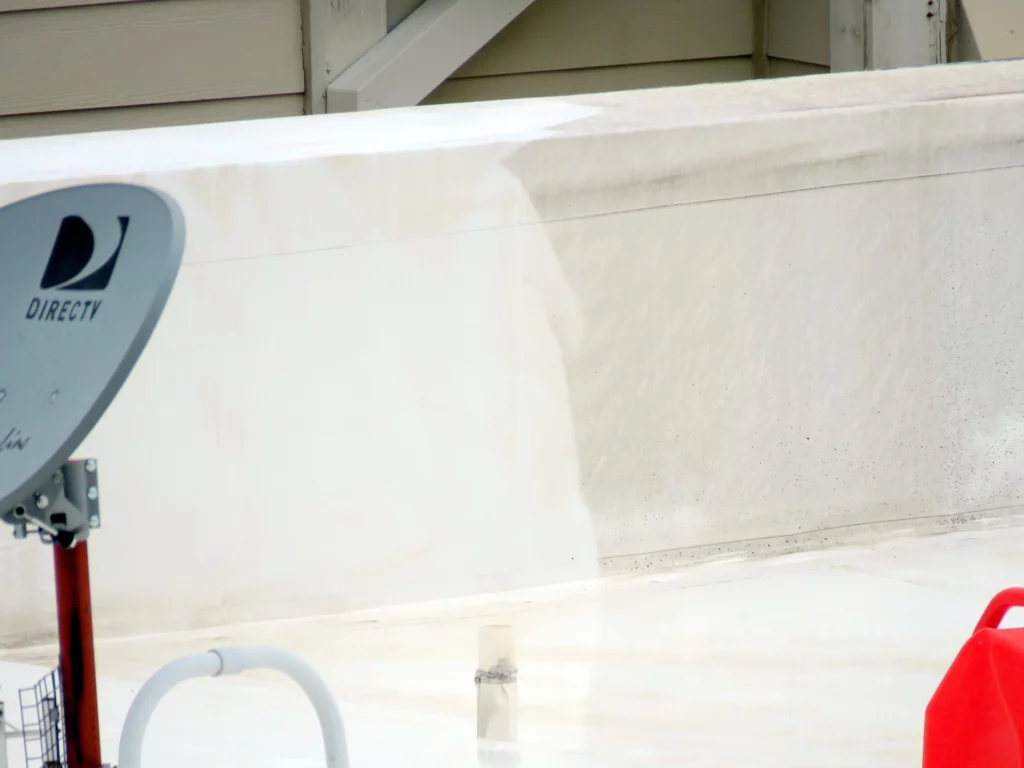
How Long Do TPO Roofing Systems Last?
A TPO roofing system can last anywhere from 15 to 40 years, depending on a number of variables.
As with all roof systems, the life expectancy of a TPO roofing system depends on how well the roof was installed (workmanship), the thickness and quality of the materials, the roof’s maintenance history, and the local climate.
Another lifespan factor with TPO is the roof system attachment method. Fully-adhered systems generally last longer than mechanically-attached systems.
Thicker roof membranes typically last longer than thinner roof membranes; this is reflected by the length of the manufacturer warranties available for each thickness level. You’ll never find a warranty for 45-mil TPO that has a longer coverage period than a warranty for 80-mil TPO.
Manufacturer warranty periods (from reputable manufacturers!) are also a good predictor of roof life expectancy. After all, manufacturers know their product, and they have a serious interest in ending warranty coverage before a roofing material reaches the end of its service life.
They also have an interest in offering the longest warranty period they can, because that helps sell roofs. They have to strike a balance: a warranty that is as long as possible without ending up costing them money due to having to cover normal end-of-life roof failure.
So the warranty periods offered by respectable TPO roofing manufacturers tend to stop about 5 – 10 years before the average TPO roof will fail due to normal, predictable material aging.
TPO Roof Lifespan by System Type
These are the commonly-accepted typical lifespans for properly-installed TPO roofing systems:
45-mil mechanically attached TPO roofing systems are typically expected to last around 20 years.
45-mil fully-adhered TPO roofing systems are typically expected to last around 25 years.
60-mil mechanically attached TPO roofing systems are typically expected to last around 25 years.
60-mil fully-adhered TPO roofing systems are typically expected to last around 30 years.
80-mil mechanically attached TPO roofing systems are typically expected last around 30 years.
80-mil fully-adhered TPO roof systems are typically expected to last around 35 years.
•••
To compare the lifespans of TPO roof systems to other types of roofing, please see our article on roof life expectancy.
Best TPO Roofing Manufacturers
Part of a roof consultant’s job is to specify the type of roofing material to be used in a roofing project, and to list the acceptable manufacturers whose products can be used for the job.
Our company has been dealing with commercial roofing manufacturers for over 50 years (some of them aren’t in business anymore).
Through our own experience and networking in the roofing industry, we’ve developed a short list of manufacturers who make quality TPO roofing.
These manufacturers have a reputation for high manufacturing standards, honoring their warranties without a lot of baseless argument, and being honest about what their products can and cannot do.
There was a study performed in 2015 to test and rank the quality of TPO roofing products from the top TPO roofing manufacturers. The study was commissioned by GAF, although it was performed by an independent testing laboratory.
If you’d like to read a very detailed summary of the study, it’s available here on the GAF website. (Edit 8/7/24: The full report is no longer available online, apparently. A summary can still be found on the website of Dezigns Construction (DCI).)
It might be a coincidence that the manufacturers in the study are the same ones on our list. We had our list before we read the study.
Remember that new TPO roofing formulations are still being tested by manufacturers. The TPO that a manufacturer was producing 10 years ago may not be the same product that they’re making today.
And just because we don’t list a manufacturer here doesn’t mean they don’t make high quality TPO. Here’s a full list of TPO roofing manufacturers.
Here’s our list of the best TPO roofing manufacturers:
Firestone Building Products (Now Holcim Elevate)
TPO Roof Repairs
If you aren’t a roofer who works with TPO, TPO roofing is one of the most difficult roofing materials to repair properly in accordance with the manufacturer’s instructions.
This is because of the heat-welding. Applying a proper TPO roof patch requires specialized TPO roofing tools (the heat welder in conjunction with the hand roller) and experience using them.
If your TPO roof is still under warranty, any repairs should be made by a roofing contractor approved by the manufacturer. You don’t want to give the manufacturer any reason to deny a future warranty claim.
Past improperly-made or unapproved repairs may be enough to void the warranty in some situations.
This goes for repairing items not even covered by the warranty, such as roof membrane punctures made by careless HVAC mechanics, for example. You still want a manufacturer-approved contractor to repair the roof.
If you have a preferred roofer who you want to use, you should call the manufacturer’s warranty department and check if it’s OK (it usually is). If you don’t have a roofer in mind, the manufacturer will give you the contact information of approved TPO roofers in your area.
If your roof warranty has expired, it’s a different ballgame. TPO roofing is among the easiest roofing materials to repair if you don’t need to do it as directed by the manufacturer for warranty reasons.
Although it’s still a good idea to have proper repairs made by a roofing contractor who has experience with TPO roofing systems, you can actually make most simple repairs yourself. You don’t need to use a heat-welder, or even TPO. Roof punctures, tears, or open roof seams can be fixed using third-party roof repair tape.
TPO is probably the most compatible single-ply roofing material there is when it comes to roof repair tape. Many roof sealant tapes use TPO as the protective backing on the tape due to its compatibility with the adhesive.
A roof patch made with a good repair tape can last more than 20 years, and if your roof is out of warranty, this probably means it will last as long as the roof does.
If you want to repair your TPO roof yourself with repair tape, you’ll need to thoroughly clean the area with warm, soapy water and follow the instructions from the tape manufacturer. We talk more about using roof repair tape (and list the good ones) here on this page.
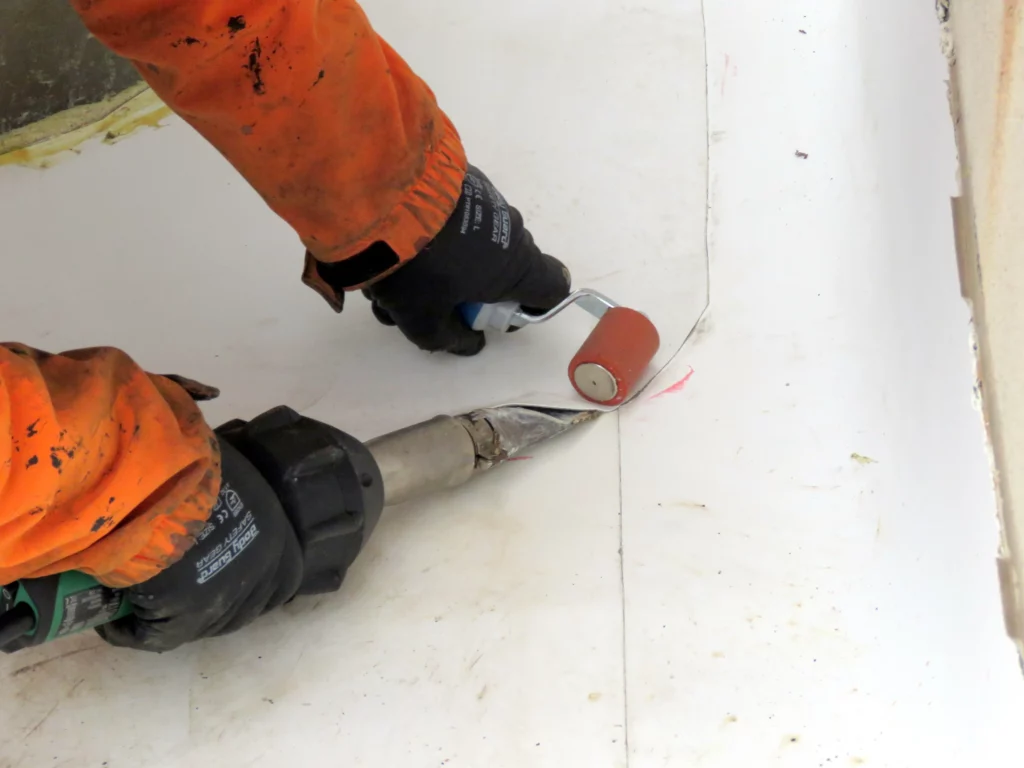
Popularity of TPO Roofing
TPO roofing is the single most popular type of roofing for new installations on flat (low-slope) roofs in the United States today.
40% of all new single-ply roof installations in 2019 used a TPO roof membrane, with that market share projected to increase over the next few years.
This means that right now, out of all new flat roofs in general, more than 3 out of every 10 are made out of TPO.
In the year 2000, almost nobody knew what TPO roofing was. The use of TPO as a roofing material has truly skyrocketed over the past 20 years.
So why is TPO roofing so popular now?
The popularity of TPO roofing has been driven mainly by a huge increase in demand for white (cool) single-ply roofing in the last 20 years. This demand is due to the savings on energy that a white roof membrane can provide by reducing building cooling expenses.
Stricter energy code requirements and the rise of LEED has made the use of white roof membranes practically mandatory in many places. But why TPO instead of one of the other white roofing materials?
In the early 2000’s, the consultants at our company knew all about TPO roofing as an alternative to white PVC and white EPDM for energy-saving cool roof installations. We also knew all about several serious issues with TPO roofing that had been identified both by researchers and by reports of real-life TPO roof failures.
We were not particularly satisfied by the reliability of TPO, and we continued to specify PVC and EPDM roofs for our clients.
Around 2010, we started to notice something curious. Whenever a client needed a roof replaced and we put the project out to bid, the contractors on our bid list started to pester us about maybe switching to a TPO membrane instead of whatever we had specified.
Eventually, we asked a few roofing manufacturer sales reps what was going on.
Apparently, there was a huge push among US roofing manufacturers to boost the volume of TPO roofing installations. The manufacturers wanted to make TPO a major part of their business because it was cheaper and easier to produce.
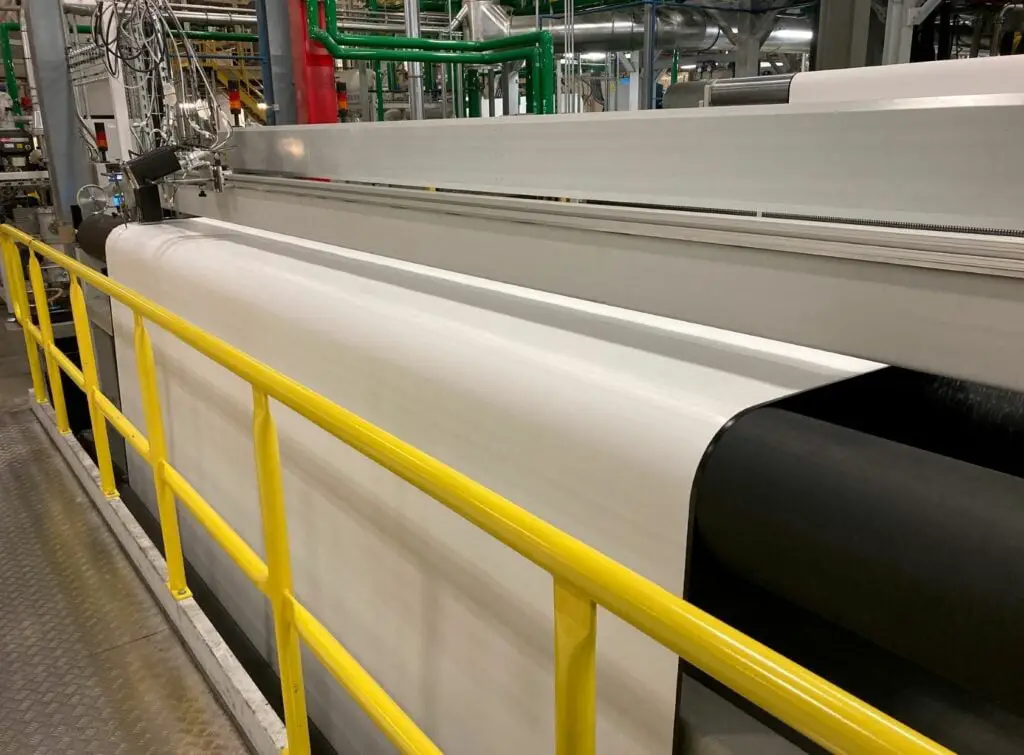
They were offering commercial roofing contractors greatly reduced prices on TPO material, which in turn led the roofing contractors to start pushing TPO every chance they got. TPO suddenly meant significantly more profit per roof for the contractors even while they charged less for a roofing job.
As the contractors installed more and more TPO roofs, they effectively trained their crews to be TPO roof installers, which made them even more likely to recommend TPO to their customers.
The lower material price of TPO also made purchasing a new roof more attractive. More customers were willing to pay for a roof replacement instead of trying to keep their old roof going as long as possible. TPO roofing sales did, in fact, increase, and in a big way.
So that explains how TPO burst onto the scene.
A TPO roof is still less expensive than its competitors in the cool roof membrane market. It currently beats the other two types of single-ply roof membrane commonly used today, white EPDM and PVC membrane, on price.
In addition, many of our early concerns about TPO have been addressed by the TPO manufacturers – TPO roofing today is a much more reliable roofing material than it was in 2005 or 2010.
TPO Roofing FAQs
What is TPO roofing?
TPO stands for Thermoplastic Olefin, a type of single-ply roofing membrane made from a blend of polypropylene and ethylene-propylene rubber. TPO roofing is a popular option for flat and low-slope roofs.
Which roof is better, EPDM or TPO?
Both EPDM and TPO are durable and reliable roofing options, but the best choice depends on the specific needs of your building. EPDM is more flexible, almost always black, and better in colder climates, while TPO is typically white, better for warmer climates, and is more resistant to punctures and tears.
Is TPO roofing expensive?
TPO roofing is generally less expensive than other flat roofing materials like PVC or modified bitumen. The cost of TPO roofing varies depending on the size of the roof, installation method, material thickness, and a few other factors.
What is the average life of a TPO roof?
The average life of a TPO roof is 20-30 years, but thicker membranes with proper maintenance can last even longer.
Can you walk on TPO roofing?
Yes, you can walk on TPO roofing, but it is important to take precautions to avoid damaging the membrane. Use soft-soled shoes and avoid walking on the roof in extreme temperatures or when the roof is wet or icy.
Why does a TPO roof leak?
TPO – thermoplastic polyolefin – roofs can leak for a variety of reasons, including improper installation, damage from foot traffic or wind-blown debris, and age-related wear and tear. Regular maintenance and inspections can help prevent leaks.
Is TPO roofing glued down?
TPO roofing systems can be installed using a variety of methods, including mechanically-attached, fully-adhered, and ballasted. Fully-adhered TPO roofing systems are glued down using a special membrane adhesive.
Does TPO roofing need underlayment?
TPO roofs do not require a separate underlayment, but a slip sheet or separation layer may be used on top of the roof to protect the membrane from abrasion due to rooftop equipment or exposure to chemicals, oils, or grease. A vapor barrier may be installed over the roof deck in some TPO systems.
What do you put under TPO roofing?
Depending on the specific installation method, TPO roofing systems will almost always require insulation, and may require a vapor barrier. A cover board is often needed over the insulation to provide a smooth, hard surface for the membrane to adhere to.
About the Author
Jack Gray is a principal roof consultant and vice president at the Moriarty Corporation, an award-winning building enclosure consultant firm founded in 1967. He is also the editor of the Roof Online website.

Mr. Gray has worked in the roofing industry for over 25 years, with training and practical experience in roof installation, roof inspection, roof safety, roof condition assessment, construction estimating, roof design & specification, quality assurance, roof maintenance & repair, and roof asset management.
He was awarded the Registered Roof Observer (RRO) professional credential in 2009.
He also served as an infantry paratrooper in the 82nd Airborne Division and has a B.A. from Cornell University. Read full bio.
Related Articles
External Sources & References for TPO Roofing Information
1. General: See this in-depth general article about various roof systems. It’s on the Whole Building Design Guide site, which is maintained by the National Institute of Building Sciences.
2. General: Evaluating Real-World Performance of Field Aged TPO Roofs is an excellent, if somewhat technical, overview of TPO roofing covering history, standards, testing, and performance of TPO roofing. Very thorough. Sponsored by GAF and presented by Jennifer Keegan, AAIA.
3. General: For a good history and overview of TPO as the fastest growing commercial roofing system, see “The rise of TPO – How TPO and PVC membranes changed the low-slope roofing market“. This 2017 article was published in Professional Roofing magazine, which is published by the National Roofing Contractors Association.
4. Building Codes: “R905.13 Thermoplastic Single-Ply Roofing” from the 2018 International Residential Code and “1507.13 Thermoplastic Single-Ply Roofing” from the 2018 International Building Code. Both available on the UpCodes website.
5. Chemical Compatibility of TPO: See this Chemical Resistance Guide for information about whether a substance will damage a TPO roof. The document is on the website of Roofing Products International.
6. Inspection of TPO Roof Systems: “TPO (Thermoplastic) Rooftop Guide/Inspection Checklist” is a handy two-page document put together by Carlisle Syntec Systems. It references Carlisle products, but it’s broadly applicable to other TPO systems.
7. Safety: See this material safety data sheet for health and safety information about TPO roofing at the GenFlex website. This is only an example and other products and brands may be different.
8. Technical – Lifespan: For an expert evaluation of TPO products, see this easy-to-follow presentation, “Critical Review of the Life Span of TPO and PVC“. It was produced by the architectural engineering firm Allana Buick & Bers, Inc. Keep in mind that this is from 2011.
9. Technical: “Technical Advisory – TPO Single-Ply Roof Systems: Performance and Service Life” is an IIBEC paper from 2016 presenting “a general overview of information regarding the performance of thermoplastic polyolefin (TPO) single-ply membranes, to summarize general information related to the evolution of TPO single-ply roof membranes, and to provide general information to assist individuals with reviewing in-place existing conditions of TPO roof membranes”.
10. Technical: See this TPO roof installation guide to see what’s going on in a typical TPO roof system. The guide is made available on the Johns Manville website.
11. Technical: See this product data sheet for the technical characteristics of TPO roofing at the Johns Manville website. This is only an example and other products and brands may be different.
12. Testing: “Testing TPOs (An unprecedented study shows surprising variations among TPO membranes)” explores TPO performance issues. The article appeared in Professional Roofing magazine in 2015.